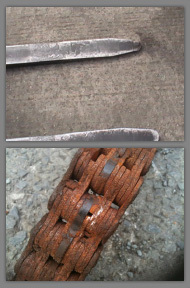Inspect Your Forks & Chains - What to Look Out For, and Why it Matters to Worker Safety
Today, let’s talk about 2 parts of the forklift we haven’t yet – the forks and chains.
Forks are solid hunks of metal. They have to be, to lift all those pallets! Treated properly, they'll last you a long time.
But forks have a lifespan too.
After a while, they’re no longer safe to use. If you do, you risk a fork snapping, dropping its load or flinging sharp debris across the warehouse!
How Fork Wear & Damage Happens
The usual causes of fork damage & wear include:
- Normal wear from use over time
- Improper chain adjustments
- Tire wear/damage (disrupts forklift stability, can cause the forks to scrape or tilt)
- Accidents (tip-over, running into racks & walls)
- Loaded beyond their rated load capacity
One thing I’ve found about fork safety is that, if you make sure to include forks in your inspections, you’ll catch problems long before any forks break.

For standard (single-shift) operations, inspect your forks every 12 months. Or whenever a defect is spotted (e.g., operator reports a fork is scratched).
When inspecting, look for:
- Surface cracks
- Straightness of the blade, and the shank
- Improper angle on the heel (beyond 90 degrees)
- Are the fork tips at the same level?
- Signs of wear on the fork surface, tips or hook
- Thickness of the fork (see the next section)
If you see any material defects, remove the fork from service immediately.
Got Fork Calipers? Fork Thickness Matters Too
Over time, the metal on a fork wears down from repeated use & load weight. It’s a slow process, but it adds up eventually.
The Industrial Truck Standards Development Foundation (ITSDF)’s safety regulations state that if a fork has lost 10% of its original thickness, either on the blade or the heel, then that fork must be removed from service.
You find out how much wear your forks have with a fork caliper. Fork calipers measure how thick a fork blade, heel & hook are. It’s a quick-use tool, showing you right away whether your forks are thick enough to continue using safely. Or whether it’s time to retire them.
Chain Safety
If a fork can wear out, the chain can too. Forklift chains typically last for 6,000 hours or 3 years of use, with proper lubrication.
Chains are more susceptible to environmental factors though. Moisture, high/low temperatures, corrosive atmosphere, abrasives (sand/gravel) and overloading will all shorten a chain’s lifespan.
Inspect chains every 6 months, at least. Look for issues like:
- Wear on link plate edges
- Protruding pins
- Elongation of the chain (total)
- Cracks
- Tight joints
- Corrosion
Tight joints can be re-lubricated. If there are no other issues, you can resume using the chain. Otherwise, replace the chain at once.
What to Do with Retired Forks
The best thing to do with damaged forks is to send them to salvage. You'll get a little money for them that way.
If you want to repair the forks, do not do the repairs yourself! You can accidentally weaken the forks further. Send forks to their manufacturer for repair instead.
If a fork or chain is damaged during shift, stop use of that forklift immediately.
(Forks and chains are available in our Parts Inventory. If you do send damaged parts off to salvage, call us for a quick replacement.)
Make Sure You Watch the Forks and Chains
If you're already inspecting your lift trucks’ forks and chains, great! Keep it up. If not, time to start.
Want some more information on taking care of your forks & chains? Use these resources:
- Cascade has a Fork Inspection Kit with a caliper, guidebook and safety poster.
- Cascade also offers a guide called "Fork Facts" (PDF). It has charts for fork types, capacity, vocabulary, and safety procedures. Plus it’s free.
If you don't have time to check forks and chains for your fleet, Cromer inspects them as part of our Major Interval Service and Fleet Planned Maintenance. Regular maintenance plans like these mean you don’t need to spend the time—but your workers are kept safe.
Until next month!
Marshall Cromer, The Forklift Boss
Cromer Material Handling



